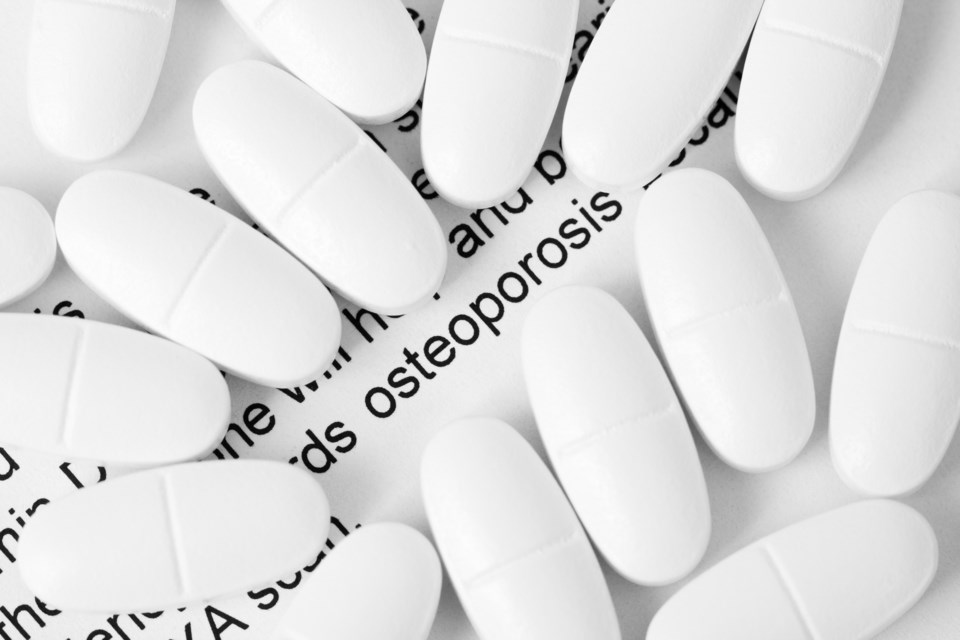Them bones, them bones, them … dense bones.
For seniors, dense bones are essential to maintaining health and wellbeing. As we age our bone density decreases, but there are some strategies we can take to keep our bones in the best possible shape.
Our bones are constantly renewed through a natural process in which new bone cells replace old bone cells. As we age, however, this process becomes less efficient, and we begin to gradually lose bone tissue. This increases our risk for osteoporosis.
The Healthlink, BC website says that “osteoporosis is a disease that affects your bones. It means that you have bones that are thin and brittle with lots of holes inside them like a sponge. This makes them easy to break. Osteoporosis can lead to broken bones (fractures) in the hip, spine, and wrist. These fractures can be disabling and may make it hard for you to live on your own.”
According to Osteoporosis Canada, it is estimated that two million Canadians are affected by osteoporosis. Information provided by Osteoporosis Canada says that people living with osteoporosis face a reduced quality of life, lowered self-esteem, reduction or loss of mobility, disfigurement, a lack of independence, and, in some cases, death – 28 per cent of women and 37 per cent of men who suffer a hip fracture will die within the following year.
Unfortunately for women, we are twice as likely as men to break a bone because of osteoporosis. Research shows that while one in five men will break a bone due to osteoporosis in their lifetime, at least one in three women will suffer a break. Women start with a lower bone density and lose bone mass more rapidly as they age.
Others refer to bone deterioration as the “silent thief” because a person may not present any symptoms until they have a fracture, and by then the disease is already advanced. According to E. Michael Lewiecki, director of the New Mexico clinical Research and Osteoporosis Centre, “we have reached a global crisis when it comes to the care of osteoporosis.”
So, what can we do? The Public Health Agency of Canada says that “it is possible to prevent, delay or reduce bone loss through a healthy lifestyle. Assessing your risk for osteoporosis and related fractures can help you identify lifestyle factors that you can change.”
Risk factors include being over 65, having a parent who had a hip fracture, being a smoker or drinking more than two units of alcohol per day on a consistent basis, being underweight or overweight, having bones which break because of a minor accident, having a spine fracture (usually detected by loss of height), and having low bone mass identified on an X-ray.
A bone-healthy lifestyle includes regular exercise and physical activity, and ensuring that you get the necessary vitamins and minerals to prevent, delay and/or reduce bone loss. Also, you may want to get your doctor to recommend a bone density test which can tell you how strong your bones are. Osteoporosis Canada advises routine bone density testing for all women and men who are age 65 or older. If you have a higher risk for fractures, it is best to start getting the test sooner.
Try a diet rich in produce, nuts, whole grain cereals, olive oil and fish. You could also try taking a supplement of calcium or vitamin D if you are not getting enough from the food you eat. A diet rich in calcium and vitamin D is essential for bone development. Your health practitioner can advise on the appropriate dosages of supplements.
Weight bearing exercises such as elliptical trainers, low impact aerobics, and walking most days of the week are recommended for older people. Muscle strengthening exercises such as using exercise bands, weightlifting, and yoga are suggested two to three times a week. Of course, if you have been reading this column regularly you know that healthy eating and regular exercise provide other wide-ranging health benefits for older people.
If you have been diagnosed with osteoporosis, it is important to reduce your risk of falling by making your home safer; avoiding taking risks in the outdoors, especially during icy weather; and making sure you take care of your vision, hearing, and feet. Remember falls are the principal reason for injury-related hospitalizations among Canadian older adults.
Now that we can get about a bit more – yes, the weather is getting better – move your body to stave off the worst effects of osteoporosis.
Margaret Coates is the co-ordinator of Lionsview Seniors’ Planning Society. She has lived on the North Shore for 51 years and has worked for and with seniors for twenty-six of those years. Ideas for future columns are welcome – email [email protected].



